Crime, Criminal Justice, and Police Investigation Analysis
VerifiedAdded on 2022/12/14
|5
|2004
|266
Homework Assignment
AI Summary
This assignment delves into several key aspects of crime and the criminal justice system. It begins by outlining various definitions of crime from sociological, dictionary, legislative, humanitarian, and social harm perspectives, as well as exploring cross-cultural norms and the labeling approach. The assignment then defines and describes criminal responsibility, discussing its relation to mental state, infancy defenses, and the concept of accountability. The analysis further examines the balance between the rights of citizens and the police during investigations, highlighting the importance of fair trial rights, privacy, and the use of technology. The assignment also explores the reasons for the emergence of new institutions that have expanded conventional forms of police investigation, such as ICAC and ACIC, and their role in addressing modern crime challenges. Finally, the assignment discusses the function and importance of discretion within the justice system, emphasizing its role in law enforcement efficiency and the ability to make fair judgments.
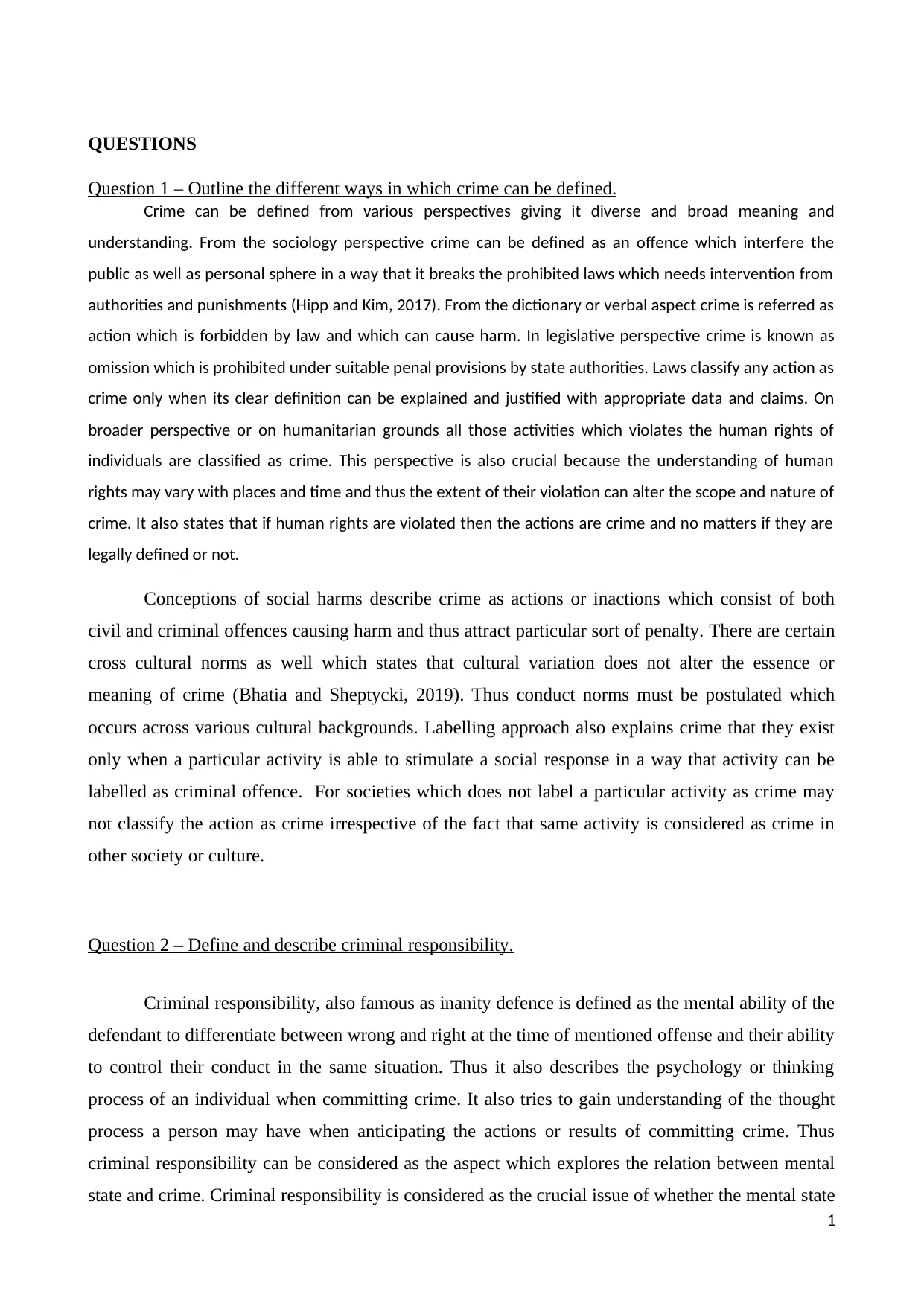
QUESTIONS
Question 1 – Outline the different ways in which crime can be defined.
Crime can be defined from various perspectives giving it diverse and broad meaning and
understanding. From the sociology perspective crime can be defined as an offence which interfere the
public as well as personal sphere in a way that it breaks the prohibited laws which needs intervention from
authorities and punishments (Hipp and Kim, 2017). From the dictionary or verbal aspect crime is referred as
action which is forbidden by law and which can cause harm. In legislative perspective crime is known as
omission which is prohibited under suitable penal provisions by state authorities. Laws classify any action as
crime only when its clear definition can be explained and justified with appropriate data and claims. On
broader perspective or on humanitarian grounds all those activities which violates the human rights of
individuals are classified as crime. This perspective is also crucial because the understanding of human
rights may vary with places and time and thus the extent of their violation can alter the scope and nature of
crime. It also states that if human rights are violated then the actions are crime and no matters if they are
legally defined or not.
Conceptions of social harms describe crime as actions or inactions which consist of both
civil and criminal offences causing harm and thus attract particular sort of penalty. There are certain
cross cultural norms as well which states that cultural variation does not alter the essence or
meaning of crime (Bhatia and Sheptycki, 2019). Thus conduct norms must be postulated which
occurs across various cultural backgrounds. Labelling approach also explains crime that they exist
only when a particular activity is able to stimulate a social response in a way that activity can be
labelled as criminal offence. For societies which does not label a particular activity as crime may
not classify the action as crime irrespective of the fact that same activity is considered as crime in
other society or culture.
Question 2 – Define and describe criminal responsibility.
Criminal responsibility, also famous as inanity defence is defined as the mental ability of the
defendant to differentiate between wrong and right at the time of mentioned offense and their ability
to control their conduct in the same situation. Thus it also describes the psychology or thinking
process of an individual when committing crime. It also tries to gain understanding of the thought
process a person may have when anticipating the actions or results of committing crime. Thus
criminal responsibility can be considered as the aspect which explores the relation between mental
state and crime. Criminal responsibility is considered as the crucial issue of whether the mental state
1
Question 1 – Outline the different ways in which crime can be defined.
Crime can be defined from various perspectives giving it diverse and broad meaning and
understanding. From the sociology perspective crime can be defined as an offence which interfere the
public as well as personal sphere in a way that it breaks the prohibited laws which needs intervention from
authorities and punishments (Hipp and Kim, 2017). From the dictionary or verbal aspect crime is referred as
action which is forbidden by law and which can cause harm. In legislative perspective crime is known as
omission which is prohibited under suitable penal provisions by state authorities. Laws classify any action as
crime only when its clear definition can be explained and justified with appropriate data and claims. On
broader perspective or on humanitarian grounds all those activities which violates the human rights of
individuals are classified as crime. This perspective is also crucial because the understanding of human
rights may vary with places and time and thus the extent of their violation can alter the scope and nature of
crime. It also states that if human rights are violated then the actions are crime and no matters if they are
legally defined or not.
Conceptions of social harms describe crime as actions or inactions which consist of both
civil and criminal offences causing harm and thus attract particular sort of penalty. There are certain
cross cultural norms as well which states that cultural variation does not alter the essence or
meaning of crime (Bhatia and Sheptycki, 2019). Thus conduct norms must be postulated which
occurs across various cultural backgrounds. Labelling approach also explains crime that they exist
only when a particular activity is able to stimulate a social response in a way that activity can be
labelled as criminal offence. For societies which does not label a particular activity as crime may
not classify the action as crime irrespective of the fact that same activity is considered as crime in
other society or culture.
Question 2 – Define and describe criminal responsibility.
Criminal responsibility, also famous as inanity defence is defined as the mental ability of the
defendant to differentiate between wrong and right at the time of mentioned offense and their ability
to control their conduct in the same situation. Thus it also describes the psychology or thinking
process of an individual when committing crime. It also tries to gain understanding of the thought
process a person may have when anticipating the actions or results of committing crime. Thus
criminal responsibility can be considered as the aspect which explores the relation between mental
state and crime. Criminal responsibility is considered as the crucial issue of whether the mental state
1
Paraphrase This Document
Need a fresh take? Get an instant paraphrase of this document with our AI Paraphraser
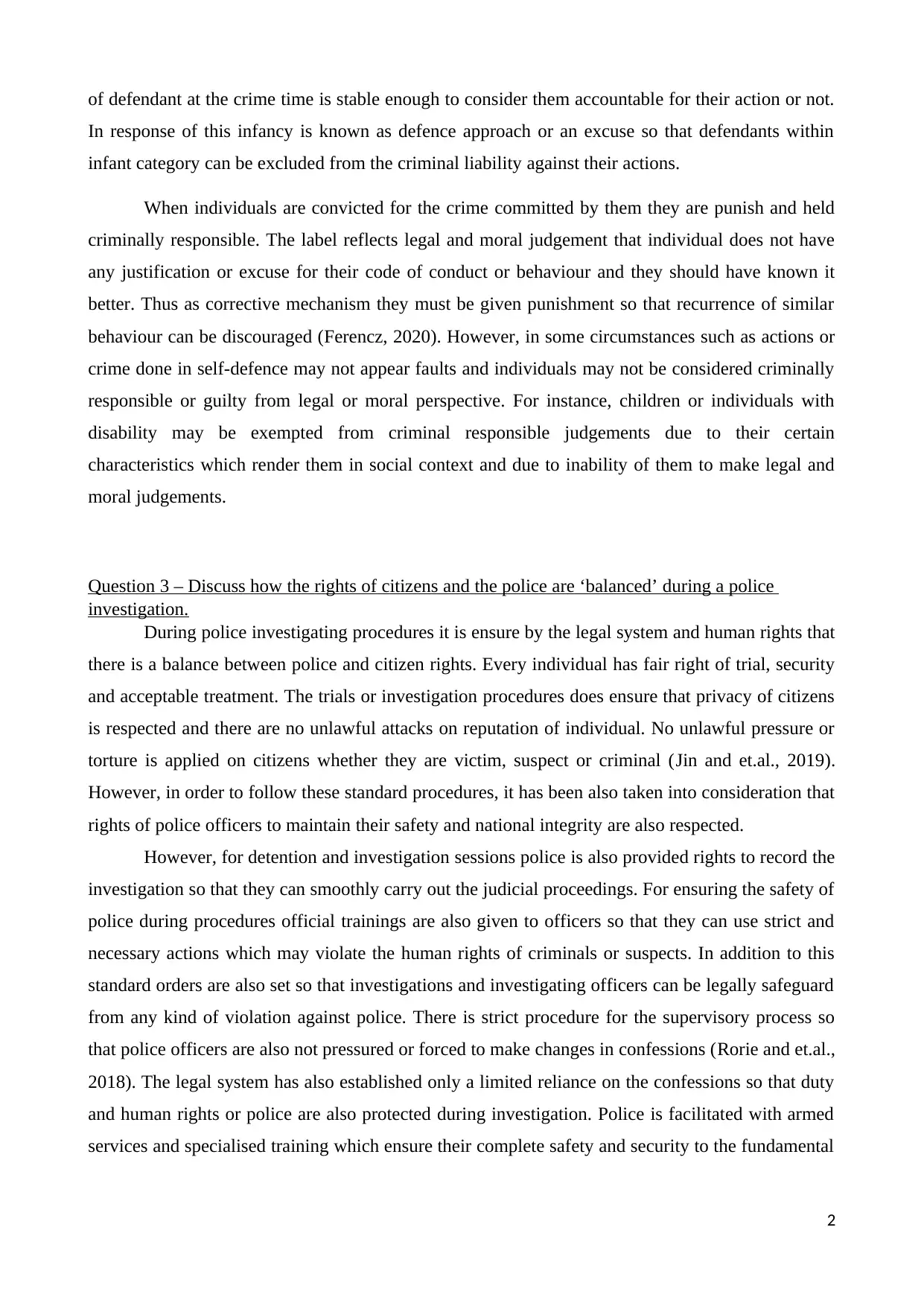
of defendant at the crime time is stable enough to consider them accountable for their action or not.
In response of this infancy is known as defence approach or an excuse so that defendants within
infant category can be excluded from the criminal liability against their actions.
When individuals are convicted for the crime committed by them they are punish and held
criminally responsible. The label reflects legal and moral judgement that individual does not have
any justification or excuse for their code of conduct or behaviour and they should have known it
better. Thus as corrective mechanism they must be given punishment so that recurrence of similar
behaviour can be discouraged (Ferencz, 2020). However, in some circumstances such as actions or
crime done in self-defence may not appear faults and individuals may not be considered criminally
responsible or guilty from legal or moral perspective. For instance, children or individuals with
disability may be exempted from criminal responsible judgements due to their certain
characteristics which render them in social context and due to inability of them to make legal and
moral judgements.
Question 3 – Discuss how the rights of citizens and the police are ‘balanced’ during a police
investigation.
During police investigating procedures it is ensure by the legal system and human rights that
there is a balance between police and citizen rights. Every individual has fair right of trial, security
and acceptable treatment. The trials or investigation procedures does ensure that privacy of citizens
is respected and there are no unlawful attacks on reputation of individual. No unlawful pressure or
torture is applied on citizens whether they are victim, suspect or criminal (Jin and et.al., 2019).
However, in order to follow these standard procedures, it has been also taken into consideration that
rights of police officers to maintain their safety and national integrity are also respected.
However, for detention and investigation sessions police is also provided rights to record the
investigation so that they can smoothly carry out the judicial proceedings. For ensuring the safety of
police during procedures official trainings are also given to officers so that they can use strict and
necessary actions which may violate the human rights of criminals or suspects. In addition to this
standard orders are also set so that investigations and investigating officers can be legally safeguard
from any kind of violation against police. There is strict procedure for the supervisory process so
that police officers are also not pressured or forced to make changes in confessions (Rorie and et.al.,
2018). The legal system has also established only a limited reliance on the confessions so that duty
and human rights or police are also protected during investigation. Police is facilitated with armed
services and specialised training which ensure their complete safety and security to the fundamental
2
In response of this infancy is known as defence approach or an excuse so that defendants within
infant category can be excluded from the criminal liability against their actions.
When individuals are convicted for the crime committed by them they are punish and held
criminally responsible. The label reflects legal and moral judgement that individual does not have
any justification or excuse for their code of conduct or behaviour and they should have known it
better. Thus as corrective mechanism they must be given punishment so that recurrence of similar
behaviour can be discouraged (Ferencz, 2020). However, in some circumstances such as actions or
crime done in self-defence may not appear faults and individuals may not be considered criminally
responsible or guilty from legal or moral perspective. For instance, children or individuals with
disability may be exempted from criminal responsible judgements due to their certain
characteristics which render them in social context and due to inability of them to make legal and
moral judgements.
Question 3 – Discuss how the rights of citizens and the police are ‘balanced’ during a police
investigation.
During police investigating procedures it is ensure by the legal system and human rights that
there is a balance between police and citizen rights. Every individual has fair right of trial, security
and acceptable treatment. The trials or investigation procedures does ensure that privacy of citizens
is respected and there are no unlawful attacks on reputation of individual. No unlawful pressure or
torture is applied on citizens whether they are victim, suspect or criminal (Jin and et.al., 2019).
However, in order to follow these standard procedures, it has been also taken into consideration that
rights of police officers to maintain their safety and national integrity are also respected.
However, for detention and investigation sessions police is also provided rights to record the
investigation so that they can smoothly carry out the judicial proceedings. For ensuring the safety of
police during procedures official trainings are also given to officers so that they can use strict and
necessary actions which may violate the human rights of criminals or suspects. In addition to this
standard orders are also set so that investigations and investigating officers can be legally safeguard
from any kind of violation against police. There is strict procedure for the supervisory process so
that police officers are also not pressured or forced to make changes in confessions (Rorie and et.al.,
2018). The legal system has also established only a limited reliance on the confessions so that duty
and human rights or police are also protected during investigation. Police is facilitated with armed
services and specialised training which ensure their complete safety and security to the fundamental
2
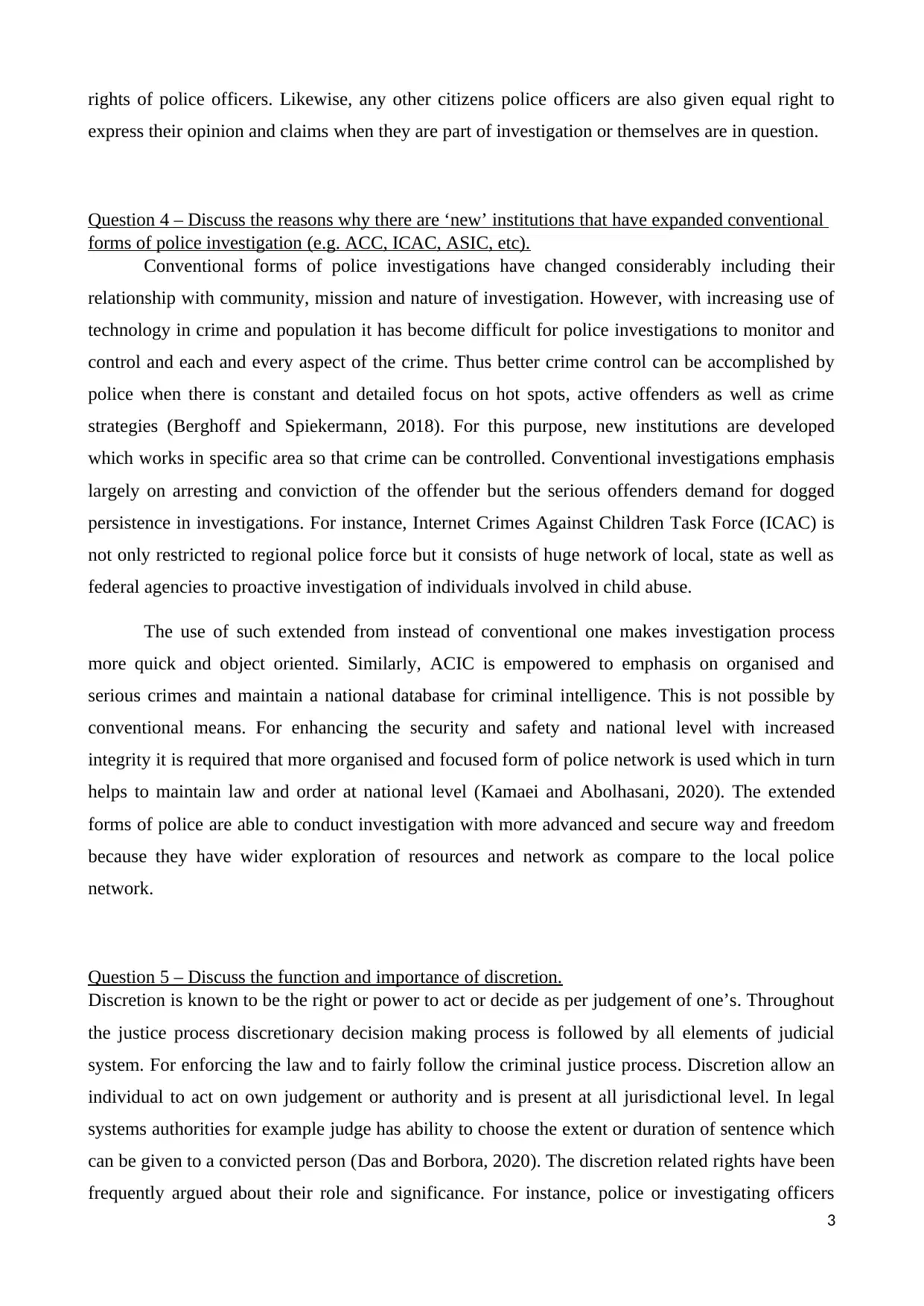
rights of police officers. Likewise, any other citizens police officers are also given equal right to
express their opinion and claims when they are part of investigation or themselves are in question.
Question 4 – Discuss the reasons why there are ‘new’ institutions that have expanded conventional
forms of police investigation (e.g. ACC, ICAC, ASIC, etc).
Conventional forms of police investigations have changed considerably including their
relationship with community, mission and nature of investigation. However, with increasing use of
technology in crime and population it has become difficult for police investigations to monitor and
control and each and every aspect of the crime. Thus better crime control can be accomplished by
police when there is constant and detailed focus on hot spots, active offenders as well as crime
strategies (Berghoff and Spiekermann, 2018). For this purpose, new institutions are developed
which works in specific area so that crime can be controlled. Conventional investigations emphasis
largely on arresting and conviction of the offender but the serious offenders demand for dogged
persistence in investigations. For instance, Internet Crimes Against Children Task Force (ICAC) is
not only restricted to regional police force but it consists of huge network of local, state as well as
federal agencies to proactive investigation of individuals involved in child abuse.
The use of such extended from instead of conventional one makes investigation process
more quick and object oriented. Similarly, ACIC is empowered to emphasis on organised and
serious crimes and maintain a national database for criminal intelligence. This is not possible by
conventional means. For enhancing the security and safety and national level with increased
integrity it is required that more organised and focused form of police network is used which in turn
helps to maintain law and order at national level (Kamaei and Abolhasani, 2020). The extended
forms of police are able to conduct investigation with more advanced and secure way and freedom
because they have wider exploration of resources and network as compare to the local police
network.
Question 5 – Discuss the function and importance of discretion.
Discretion is known to be the right or power to act or decide as per judgement of one’s. Throughout
the justice process discretionary decision making process is followed by all elements of judicial
system. For enforcing the law and to fairly follow the criminal justice process. Discretion allow an
individual to act on own judgement or authority and is present at all jurisdictional level. In legal
systems authorities for example judge has ability to choose the extent or duration of sentence which
can be given to a convicted person (Das and Borbora, 2020). The discretion related rights have been
frequently argued about their role and significance. For instance, police or investigating officers
3
express their opinion and claims when they are part of investigation or themselves are in question.
Question 4 – Discuss the reasons why there are ‘new’ institutions that have expanded conventional
forms of police investigation (e.g. ACC, ICAC, ASIC, etc).
Conventional forms of police investigations have changed considerably including their
relationship with community, mission and nature of investigation. However, with increasing use of
technology in crime and population it has become difficult for police investigations to monitor and
control and each and every aspect of the crime. Thus better crime control can be accomplished by
police when there is constant and detailed focus on hot spots, active offenders as well as crime
strategies (Berghoff and Spiekermann, 2018). For this purpose, new institutions are developed
which works in specific area so that crime can be controlled. Conventional investigations emphasis
largely on arresting and conviction of the offender but the serious offenders demand for dogged
persistence in investigations. For instance, Internet Crimes Against Children Task Force (ICAC) is
not only restricted to regional police force but it consists of huge network of local, state as well as
federal agencies to proactive investigation of individuals involved in child abuse.
The use of such extended from instead of conventional one makes investigation process
more quick and object oriented. Similarly, ACIC is empowered to emphasis on organised and
serious crimes and maintain a national database for criminal intelligence. This is not possible by
conventional means. For enhancing the security and safety and national level with increased
integrity it is required that more organised and focused form of police network is used which in turn
helps to maintain law and order at national level (Kamaei and Abolhasani, 2020). The extended
forms of police are able to conduct investigation with more advanced and secure way and freedom
because they have wider exploration of resources and network as compare to the local police
network.
Question 5 – Discuss the function and importance of discretion.
Discretion is known to be the right or power to act or decide as per judgement of one’s. Throughout
the justice process discretionary decision making process is followed by all elements of judicial
system. For enforcing the law and to fairly follow the criminal justice process. Discretion allow an
individual to act on own judgement or authority and is present at all jurisdictional level. In legal
systems authorities for example judge has ability to choose the extent or duration of sentence which
can be given to a convicted person (Das and Borbora, 2020). The discretion related rights have been
frequently argued about their role and significance. For instance, police or investigating officers
3
⊘ This is a preview!⊘
Do you want full access?
Subscribe today to unlock all pages.

Trusted by 1+ million students worldwide
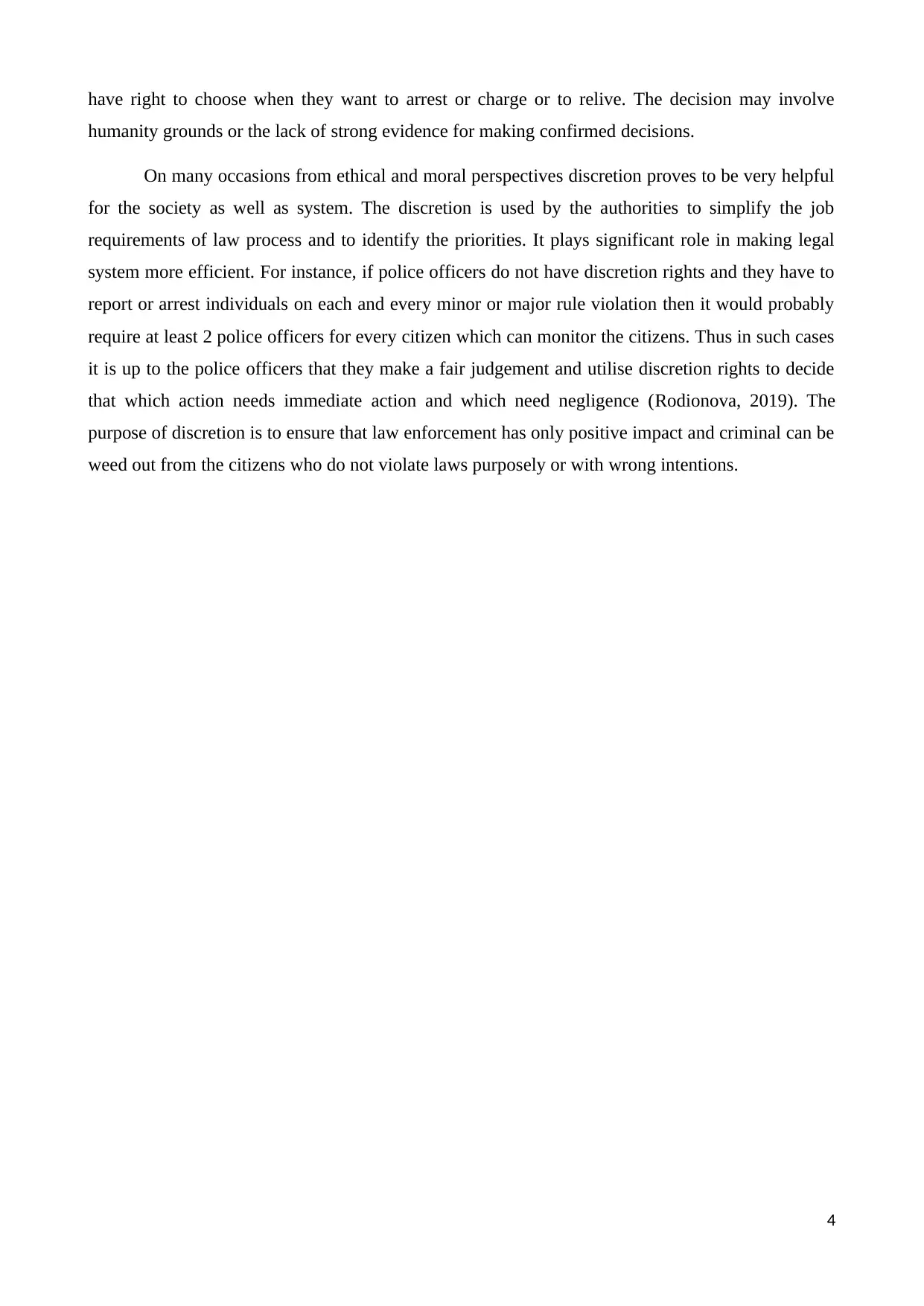
have right to choose when they want to arrest or charge or to relive. The decision may involve
humanity grounds or the lack of strong evidence for making confirmed decisions.
On many occasions from ethical and moral perspectives discretion proves to be very helpful
for the society as well as system. The discretion is used by the authorities to simplify the job
requirements of law process and to identify the priorities. It plays significant role in making legal
system more efficient. For instance, if police officers do not have discretion rights and they have to
report or arrest individuals on each and every minor or major rule violation then it would probably
require at least 2 police officers for every citizen which can monitor the citizens. Thus in such cases
it is up to the police officers that they make a fair judgement and utilise discretion rights to decide
that which action needs immediate action and which need negligence (Rodionova, 2019). The
purpose of discretion is to ensure that law enforcement has only positive impact and criminal can be
weed out from the citizens who do not violate laws purposely or with wrong intentions.
4
humanity grounds or the lack of strong evidence for making confirmed decisions.
On many occasions from ethical and moral perspectives discretion proves to be very helpful
for the society as well as system. The discretion is used by the authorities to simplify the job
requirements of law process and to identify the priorities. It plays significant role in making legal
system more efficient. For instance, if police officers do not have discretion rights and they have to
report or arrest individuals on each and every minor or major rule violation then it would probably
require at least 2 police officers for every citizen which can monitor the citizens. Thus in such cases
it is up to the police officers that they make a fair judgement and utilise discretion rights to decide
that which action needs immediate action and which need negligence (Rodionova, 2019). The
purpose of discretion is to ensure that law enforcement has only positive impact and criminal can be
weed out from the citizens who do not violate laws purposely or with wrong intentions.
4
Paraphrase This Document
Need a fresh take? Get an instant paraphrase of this document with our AI Paraphraser
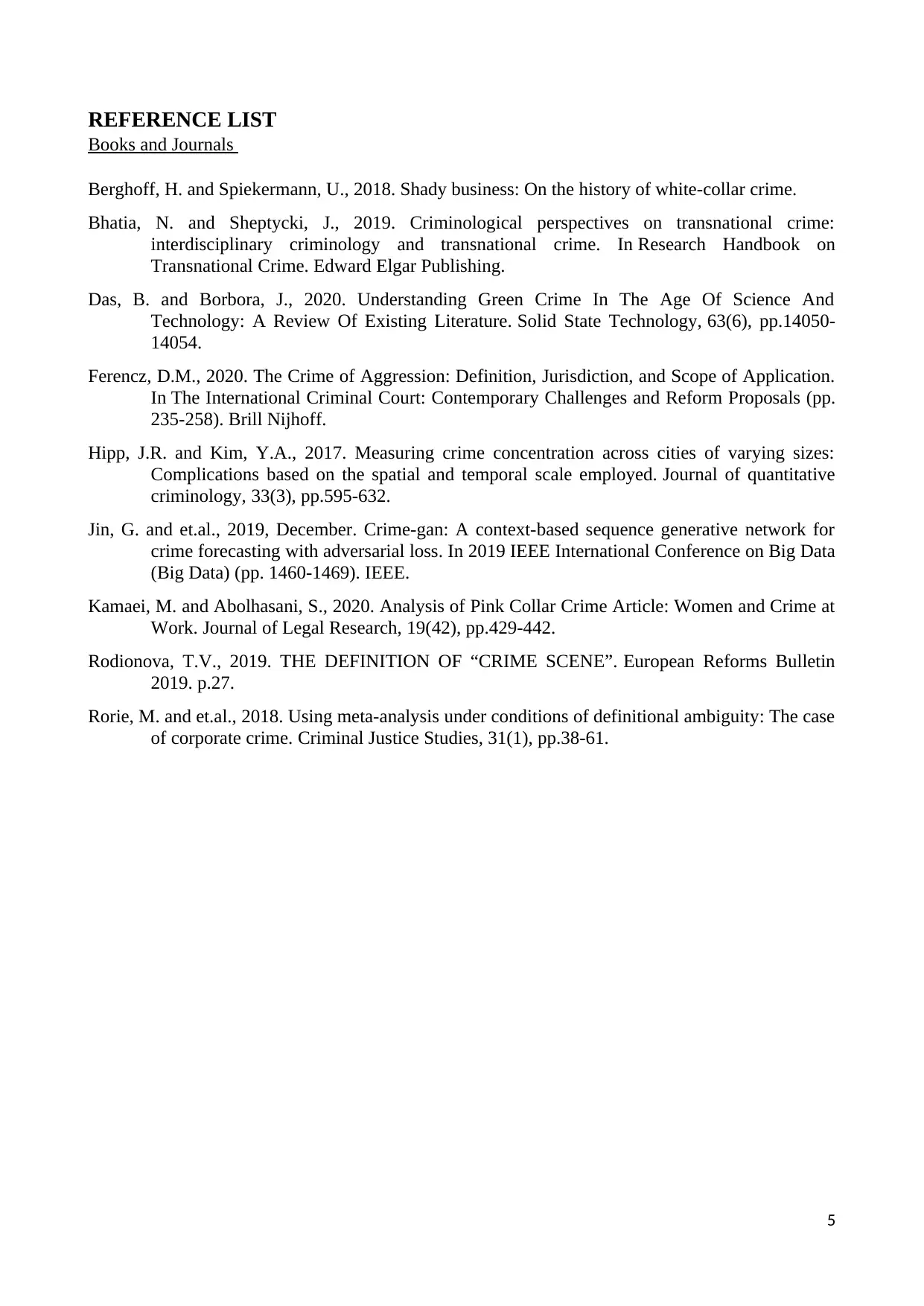
REFERENCE LIST
Books and Journals
Berghoff, H. and Spiekermann, U., 2018. Shady business: On the history of white-collar crime.
Bhatia, N. and Sheptycki, J., 2019. Criminological perspectives on transnational crime:
interdisciplinary criminology and transnational crime. In Research Handbook on
Transnational Crime. Edward Elgar Publishing.
Das, B. and Borbora, J., 2020. Understanding Green Crime In The Age Of Science And
Technology: A Review Of Existing Literature. Solid State Technology, 63(6), pp.14050-
14054.
Ferencz, D.M., 2020. The Crime of Aggression: Definition, Jurisdiction, and Scope of Application.
In The International Criminal Court: Contemporary Challenges and Reform Proposals (pp.
235-258). Brill Nijhoff.
Hipp, J.R. and Kim, Y.A., 2017. Measuring crime concentration across cities of varying sizes:
Complications based on the spatial and temporal scale employed. Journal of quantitative
criminology, 33(3), pp.595-632.
Jin, G. and et.al., 2019, December. Crime-gan: A context-based sequence generative network for
crime forecasting with adversarial loss. In 2019 IEEE International Conference on Big Data
(Big Data) (pp. 1460-1469). IEEE.
Kamaei, M. and Abolhasani, S., 2020. Analysis of Pink Collar Crime Article: Women and Crime at
Work. Journal of Legal Research, 19(42), pp.429-442.
Rodionova, T.V., 2019. THE DEFINITION OF “CRIME SCENE”. European Reforms Bulletin
2019. p.27.
Rorie, M. and et.al., 2018. Using meta-analysis under conditions of definitional ambiguity: The case
of corporate crime. Criminal Justice Studies, 31(1), pp.38-61.
5
Books and Journals
Berghoff, H. and Spiekermann, U., 2018. Shady business: On the history of white-collar crime.
Bhatia, N. and Sheptycki, J., 2019. Criminological perspectives on transnational crime:
interdisciplinary criminology and transnational crime. In Research Handbook on
Transnational Crime. Edward Elgar Publishing.
Das, B. and Borbora, J., 2020. Understanding Green Crime In The Age Of Science And
Technology: A Review Of Existing Literature. Solid State Technology, 63(6), pp.14050-
14054.
Ferencz, D.M., 2020. The Crime of Aggression: Definition, Jurisdiction, and Scope of Application.
In The International Criminal Court: Contemporary Challenges and Reform Proposals (pp.
235-258). Brill Nijhoff.
Hipp, J.R. and Kim, Y.A., 2017. Measuring crime concentration across cities of varying sizes:
Complications based on the spatial and temporal scale employed. Journal of quantitative
criminology, 33(3), pp.595-632.
Jin, G. and et.al., 2019, December. Crime-gan: A context-based sequence generative network for
crime forecasting with adversarial loss. In 2019 IEEE International Conference on Big Data
(Big Data) (pp. 1460-1469). IEEE.
Kamaei, M. and Abolhasani, S., 2020. Analysis of Pink Collar Crime Article: Women and Crime at
Work. Journal of Legal Research, 19(42), pp.429-442.
Rodionova, T.V., 2019. THE DEFINITION OF “CRIME SCENE”. European Reforms Bulletin
2019. p.27.
Rorie, M. and et.al., 2018. Using meta-analysis under conditions of definitional ambiguity: The case
of corporate crime. Criminal Justice Studies, 31(1), pp.38-61.
5
1 out of 5
Related Documents
Your All-in-One AI-Powered Toolkit for Academic Success.
+13062052269
info@desklib.com
Available 24*7 on WhatsApp / Email
![[object Object]](/_next/static/media/star-bottom.7253800d.svg)
Unlock your academic potential
Copyright © 2020–2025 A2Z Services. All Rights Reserved. Developed and managed by ZUCOL.




